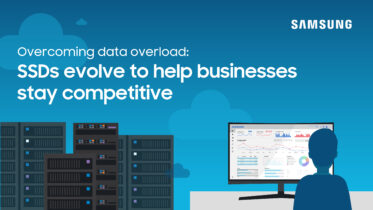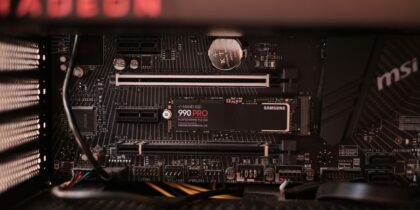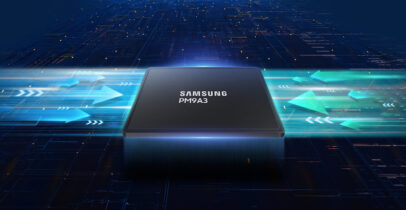Local, state and federal government agencies must store and manage ever-increasing amounts of data, from email and public records to public health databases and video from security cameras. In some cases, they have to provide fast data access to employees so they can work or to constituents who need to renew licenses or pay their bills and taxes online.
To meet performance requirements and manage data efficiently and cost-effectively, the public sector is increasingly adopting solid state drives (SSDs) over traditional hard disk drives (HDDs) due to their improved performance, security and reliability.
Let’s dive into five SSD-related storage trends that can improve overall government efficiency and demonstrate how to improve public sector performance.
1. Increased adoption of NVMe® PCIe® storage
Data center SSDs have historically used the SATA and SAS interfaces to connect to servers. Even though they were designed for spinning disks, SATA and SAS SSDs are much faster than HDDs at reading and writing data.
Now, SSDs are even faster due to the emergence of the high-speed NVMe protocol, which is purpose-built for flash memory, runs on a PCIe interface and significantly speeds up application performance.
A government agency that needs to perform mission-critical, performance-intensive tasks, such as database queries, data analytics and AI, can gain faster insights with NVMe PCIe-based SSDs. With faster speeds, NVMe PCIe-based SSDs can also improve worker productivity and accelerate new digital-citizen services.
Samsung PM9A3 NVMe SSD is a blazing-fast storage solution for data centers. The PM9A3, which supports the newest, much faster PCIe 4.0 interface, supports sequential read/write speeds of up to 6,900/4,100 MB/s and random read/write speeds of up to 1,100K/200K IOPS. The random write speed is 3.6 times faster than the previous generation Samsung NVMe data center SSD .
The PM9A3, available in E1.S, U.2 and M.2 form factors, supports capacities of 960GB to 15.36TB.
2. Lower total cost of ownership
Data center SSD prices dropped significantly in recent years, making their pricing competitive with HDDs. In fact, SSDs can offer a lower total cost of ownership (TCO) than their HDD counterparts. SSDs provide higher performance per drive, which means instead of buying more HDDs, agencies implementing virtual desktop infrastructure (VDI) can spend less on fewer SSDs and still get the performance they need.
Fewer SSDs means saving space and reducing power and cooling needs. In addition, while HDDs have mechanical parts and spinning disks, SSDs have no moving parts, so they are more reliable. All of these benefits combined — better performance in a smaller footprint, energy savings and streamlined maintenance — can add up to better cost savings.
Samsung offers a family of data center SSDs to meet every agency’s data requirements. While PM9A3 NVMe SSD from Samsung offers the fastest performance, their PM893 SATA SSD provides strong performance at a cost-effective price.
The PM893 SSD, designed to store massive amounts of data, supports capacities from 240GB to 7.6TB and offers maximum sequential read/write speeds of 550/520 MB/s and maximum read/write speeds of 98,000/30,000 IOPS.
How to solve government data challenges with SSDs
SSDs provide a reliable solution for managing large amounts of data in the public sector securely. Download Now
Its 2.5-inch form factor and SATA interface enables agencies to upgrade from legacy HDD storage without having to upgrade existing IT infrastructure.
Both the Samsung PM9A3 and PM893 SSDs are highly reliable and energy-efficient, and they protect against data corruption in the event of power failure, which means less time and money spent on recovering data.
The PM9A3, for example, offers a power efficiency of 238MB per second per watt for sequential writes, which is nearly a 50% improvement over previous generation Samsung NVMe SSDs.
3. Software-defined storage
There is increased adoption of software-defined storage (SDS), which enables agencies to manage storage on commodity x86 servers1 and is more cost-effective and easier to manage than monolithic storage area networks (SAN) and network-attached storage (NAS) hardware.
SDS disaggregates storage from on-premises hardware, such as SSDs on a cluster of x86 servers, and combines them into a unified pool of storage that can be centrally managed and provisioned through a single management tool.
Vendors take different approaches to SDS. One increasingly popular solution among enterprises — including the public sector — is hyperconverged infrastructure (HCI) software, an integrated software stack that allows IT administrators to manage server, storage, networking and virtualization through a single interface. Other SDS vendors offer software that only manages storage. Some SDS solutions, including HCI, support a hybrid cloud approach, allowing agencies to manage storage on-premises and in the public cloud.
SDS enables better storage utilization, scalability and flexibility. With siloed storage, one storage system may use 90% of storage capacity, while another only uses 30%. By pooling storage together, agencies can increase the utilization of all their storage resources. In addition, agencies no longer need to overprovision storage like they have historically with SAN and NAS devices. With SDS, they can simply add more SSDs as needed.
4. Edge computing
Enterprises are increasingly adopting edge data centers, which are small or micro data centers located at the edge of the network and closer to users and devices. Having computing power and storage at the edge enables agencies to process, analyze and store data where it’s generated, improving public sector efficiency. Edge computing also improves performance, reduces latency and lowers bandwidth costs, as agencies don’t have to move the data off-site to central data centers or the public cloud to process it.
SSDs are a perfect solution for edge data centers because they enable faster application speeds. According to an Accenture report2, 60% of federal IT leaders said the pandemic increased their agencies’ interest in adopting edge solutions to enable remote work. Other current use cases include the Federal Emergency Management Agency (FEMA) using edge computing for disaster response, and the U.S. Postal Service using edge computing in distribution centers to process packages efficiently. The U.S. Department of Agriculture is also using edge computing and the Internet of Things (IoT) to monitor and analyze farm conditions.
5. Strong security
Government agencies are under constant attack by hackers, so they must invest heavily in security to protect data. In fact, most cyber experts polled by the Washington Post said the U.S. is either just as vulnerable or more vulnerable3 to cyberattacks today compared to five years ago.
Samsung data center SSDs can help agencies protect data with hardware-based, full-disk encryption, which is more secure than software-based encryption available on HDDs. As the name implies, software-based encryption occurs in the software layer. Hackers who break into the system can intercept the data and might hack the encryption key. In contrast, hardware-based encryption uses its own processor and is isolated from the rest of the drives and resources on the machine.
Both the Samsung PM9A3 and PM893 SSDs support AES 256-bit full-disk encryption, which is the strongest encryption algorithm available today.
Samsung SSDs not only improve performance, but they’re also cost-effective and can increase government efficiency and security.
Further explore how SSDs can lower costs and downtime for government workers. Contact a Sales expert today.
1 TechTarget. “Software-defined storage (SDS)” July 28, 2023.
2 Accenture. “Federal edge solutions: Extending IT to the mission’s edge.” September 13, 2021.
3 The Washington Post. “The U.S. isn’t getting ahead of the cyber threat experts say.” June 6, 2022







